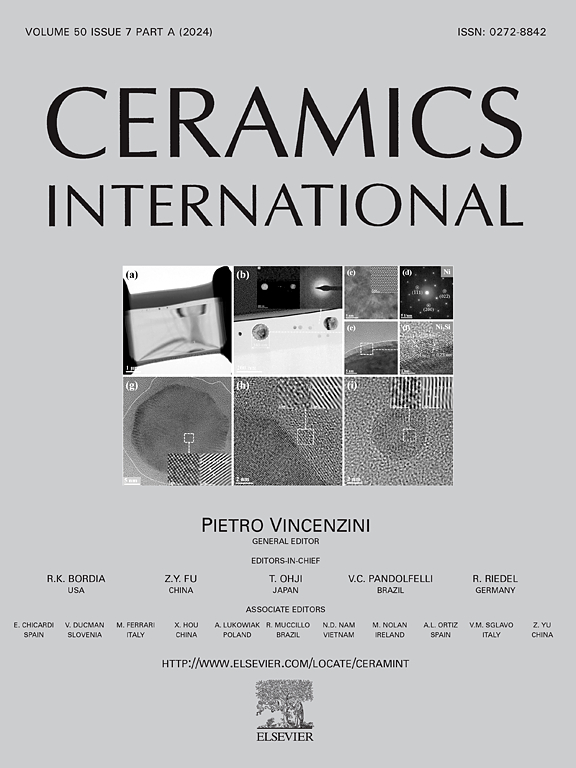Synthesis, mechanical, and dielectric properties of BaO–CdO–PbO–CeO2–B2O3 glass system through Sm2O3 doping for advanced dielectric applications
IF 5.1
2区 材料科学
Q1 MATERIALS SCIENCE, CERAMICS
引用次数: 0
Abstract
The fundamental goal of this work is to understand the impact of doping Sm2O3 on the structure, physical, mechanical, and electrical properties of glasses having a composition of 10 BaO −10CdO-20PbO-X Sm2O3-(56-X)B2O3, where X = 0, 0.5, 1.0 and 2 mol%. FTIR spectroscopy reveals structural modifications in Sm2O3-doped BaO–CdO–PbO–CeO2–B2O3 glasses. Four spectral regions show systematic conversion of BO4 to BO3 units with increasing Sm2O3 content. Results confirm Sm2O3's role as a network modifier through non-bridging oxygen evolution and borate structural units' transformations. The addition of Sm2O3 resulted in decrease rigidity and strength of the glasses network and slightly decrease elastic modulus parameters. The dielectric properties of Sm2O3-doped glass composites are evaluated across frequency and temperature. With Sm2O3 doping, permittivity is reduced because of charge localization and low charge mobility. AC conductivity has a low frequency suppression due to strong bonding with Sm–O and a high frequency enhancement through the defect states for electronic hopping. Dielectric loss exhibits several relaxation peaks which shift with temperature and composition. Findings suggest that dielectric tuning for electronic applications can be achieved by balancing a slight decrease in permittivity with a significant reduction in dielectric loss and improved thermal stability. The results showed that synthesized glasses, especially those with high Sm2O3 content can be used as high-performance capacitor applications.
Sm2O3掺杂BaO-CdO-PbO-CeO2-B2O3玻璃体系的合成、力学和介电性能
这项工作的基本目标是了解掺杂Sm2O3对具有10 BaO−10CdO-20PbO-X Sm2O3-(56-X)B2O3组成的玻璃的结构,物理,机械和电学性能的影响,其中X = 0,0.5, 1.0和2mol %。FTIR光谱揭示了sm2o3掺杂的BaO-CdO-PbO-CeO2-B2O3玻璃的结构变化。随着Sm2O3含量的增加,四个光谱区显示BO4向BO3单位的系统转化。结果证实Sm2O3通过非桥式析氧和硼酸盐结构单元的转变,起到了网络改性剂的作用。Sm2O3的加入导致玻璃网的刚度和强度降低,弹性模量参数略有降低。研究了sm2o3掺杂玻璃复合材料在不同频率和温度下的介电性能。Sm2O3掺杂后,由于电荷局域化和电荷迁移率降低,电介电常数降低。交流电导率由于与Sm-O的强结合而具有低频抑制,而通过电子跳变缺陷态具有高频增强。介质损耗表现出几个随温度和成分变化的弛豫峰。研究结果表明,电子应用的介电调谐可以通过平衡介电常数的轻微下降与介电损耗的显著降低和热稳定性的提高来实现。结果表明,合成的玻璃,特别是Sm2O3含量高的玻璃,可以作为高性能电容器的应用。
本文章由计算机程序翻译,如有差异,请以英文原文为准。
求助全文
约1分钟内获得全文
求助全文
来源期刊

Ceramics International
工程技术-材料科学:硅酸盐
CiteScore
9.40
自引率
15.40%
发文量
4558
审稿时长
25 days
期刊介绍:
Ceramics International covers the science of advanced ceramic materials. The journal encourages contributions that demonstrate how an understanding of the basic chemical and physical phenomena may direct materials design and stimulate ideas for new or improved processing techniques, in order to obtain materials with desired structural features and properties.
Ceramics International covers oxide and non-oxide ceramics, functional glasses, glass ceramics, amorphous inorganic non-metallic materials (and their combinations with metal and organic materials), in the form of particulates, dense or porous bodies, thin/thick films and laminated, graded and composite structures. Process related topics such as ceramic-ceramic joints or joining ceramics with dissimilar materials, as well as surface finishing and conditioning are also covered. Besides traditional processing techniques, manufacturing routes of interest include innovative procedures benefiting from externally applied stresses, electromagnetic fields and energetic beams, as well as top-down and self-assembly nanotechnology approaches. In addition, the journal welcomes submissions on bio-inspired and bio-enabled materials designs, experimentally validated multi scale modelling and simulation for materials design, and the use of the most advanced chemical and physical characterization techniques of structure, properties and behaviour.
Technologically relevant low-dimensional systems are a particular focus of Ceramics International. These include 0, 1 and 2-D nanomaterials (also covering CNTs, graphene and related materials, and diamond-like carbons), their nanocomposites, as well as nano-hybrids and hierarchical multifunctional nanostructures that might integrate molecular, biological and electronic components.
 求助内容:
求助内容: 应助结果提醒方式:
应助结果提醒方式:


